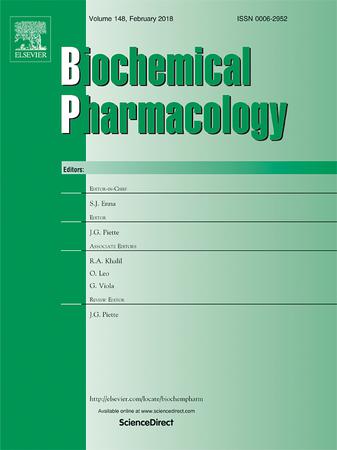阿司匹林通过Sonic hedgehog信号逆转了可溶性类膜酪氨酸激酶-1对滋养细胞侵袭和纤毛发生的抑制作用
IF 5.6
2区 医学
Q1 PHARMACOLOGY & PHARMACY
引用次数: 0
摘要
可溶性Flt-1 (sFlt-1)在子痫前期患者中上调,是子痫前期风险和进展的预测性生物标志物。阿司匹林是一种用于预防子痫前期的有效药物,并已被证明可抑制滋养细胞中sFlt-1的产生;然而,其潜在的机制尚不完全清楚。在这里,我们证明了两种滋养细胞(HTR-8/SVneo和JAR)在缺氧条件下sFlt-1的表达上调。在缺氧条件下和子痫前期小鼠模型中,研究了sFlt-1预处理、flt -1敲除的HTR-8/SVneo细胞中,sFlt-1及其通路对滋养细胞生物学和纤毛形成的影响。本研究发现,sFlt-1通过下调ZEB1/2、MMP / 2/9和Sonic hedgehog (SHH)信号通路来抑制缺氧条件下滋养细胞的侵袭和迁移。滋养细胞纤毛数量和纤毛长度受sFlt-1抑制,而FLT-1敲除后纤毛数量和纤毛长度增加。研究发现阿司匹林可以逆转sflt -1介导的对HTR-8/SVneo细胞中滋养细胞侵袭/迁移、纤毛发生和SHH信号传导的抑制作用。此外,在子痫前期小鼠模型中,血浆和胎盘sFlt-1蛋白水平上调,而小鼠胎盘中原发性纤毛形成和shh相关表达受损。在子痫前期小鼠模型中,阿司匹林喂养小鼠的sFlt-1表达降低,胎盘纤毛发生和SHH表达改善。综上所述,sFlt-1在缺氧条件下通过SHH信号通路影响滋养细胞的运动和纤毛发生。在体外和体内,阿司匹林对sFlt-1上调及sFlt-1介导的细胞功能和信号传导有抑制作用。本文章由计算机程序翻译,如有差异,请以英文原文为准。

Aspirin reverses the inhibitory effect of soluble fms-like tyrosine kinase-1 on trophoblast invasiveness and ciliogenesis through Sonic hedgehog signaling in preeclampsia
Soluble Flt-1 (sFlt-1) is upregulated in preeclamptic patients and is a predictive biomarker for preeclampsia risk and progression. Aspirin is an effective agent used to prevent preeclampsia and has been shown to suppress sFlt-1 production in trophoblasts; however, the underlying mechanism is not fully understood. Here, we demonstrated that sFlt-1 production was upregulated under hypoxia in two trophoblastic cells (HTR-8/SVneo and JAR). The effects of sFlt-1 and underlying pathways on trophoblast biology and cilia formation were investigated in sFlt-1-pretreated, FLT-1-knockdown HTR-8/SVneo cells under hypoxic conditions and in a preeclampsia mouse model. In the present study, sFlt-1 was shown to inhibit trophoblast invasion and migration under hypoxia, and this inhibitory effect occurred through downregulating ZEB1/2, MMP 2/9, and the Sonic hedgehog (SHH) signaling pathway. Ciliary number and length of trophoblasts were inhibited by sFlt-1 treatment and were enhanced after FLT-1 knockdown. Aspirin was found to reverse the sFlt-1-mediated inhibitory effect on trophoblast invasion/migration, ciliogenesis, and SHH signaling in HTR-8/SVneo cells. Moreover, plasma and placental sFlt-1 protein levels were upregulated in the preeclampsia mouse model, whereas primary cilia formation and SHH-related expression were impaired in the mouse placenta. Aspirin-fed mice presented with reduced sFlt-1 expression, and their placental ciliogenesis and SHH expression were improved in the preeclamptic mouse model. In conclusion, sFlt-1 impairs trophoblast motility and ciliogenesis through SHH signaling under hypoxia. Aspirin exerts its suppressive effect on sFlt-1 upregulation and sFlt-1-mediated cell function and signaling in vitro and in vivo.
求助全文
通过发布文献求助,成功后即可免费获取论文全文。
去求助
来源期刊

Biochemical pharmacology
医学-药学
CiteScore
10.30
自引率
1.70%
发文量
420
审稿时长
17 days
期刊介绍:
Biochemical Pharmacology publishes original research findings, Commentaries and review articles related to the elucidation of cellular and tissue function(s) at the biochemical and molecular levels, the modification of cellular phenotype(s) by genetic, transcriptional/translational or drug/compound-induced modifications, as well as the pharmacodynamics and pharmacokinetics of xenobiotics and drugs, the latter including both small molecules and biologics.
The journal''s target audience includes scientists engaged in the identification and study of the mechanisms of action of xenobiotics, biologics and drugs and in the drug discovery and development process.
All areas of cellular biology and cellular, tissue/organ and whole animal pharmacology fall within the scope of the journal. Drug classes covered include anti-infectives, anti-inflammatory agents, chemotherapeutics, cardiovascular, endocrinological, immunological, metabolic, neurological and psychiatric drugs, as well as research on drug metabolism and kinetics. While medicinal chemistry is a topic of complimentary interest, manuscripts in this area must contain sufficient biological data to characterize pharmacologically the compounds reported. Submissions describing work focused predominately on chemical synthesis and molecular modeling will not be considered for review.
While particular emphasis is placed on reporting the results of molecular and biochemical studies, research involving the use of tissue and animal models of human pathophysiology and toxicology is of interest to the extent that it helps define drug mechanisms of action, safety and efficacy.
 求助内容:
求助内容: 应助结果提醒方式:
应助结果提醒方式:


